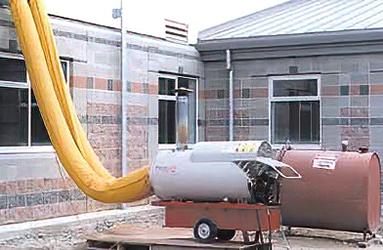
Most homes in Canada are now equipped with a carbon monoxide detector. We know the deadly consequences of not having this life-saving device installed in our houses. But are you protected against this hazard at work?
Carbon monoxide poisoning has been the cause of many injuries, illnesses, and fatalities in Ontario workplaces. As the cold weather approaches, windows and doors are closed up tight, temporary heaters are used more frequently, and tarps are installed to retain heat. Changes like these increase the risk of exposure to carbon monoxide in the workplace when fuel-powered equipment is being used. Because of this increased risk, workers need to be made aware of the dangers and how to protect themselves.
What is carbon monoxide?
Carbon monoxide (chemical abbreviation: CO) is a colourless, odourless, and highly poisonous gas. It is produced by the incomplete burning of fuels. Engines powered by gasoline, propane, or diesel release carbon monoxide. So do fuel-fired heaters and certain welding processes.
Since you cannot see or smell CO, you need a detector to warn if this hazard is present. Breathing in CO gas interferes with your body’s ability to use oxygen.
CO gas can accumulate in any enclosed or poorly ventilated space where a source of CO is being operated.
These include:
- Vehicle and equipment cabs
- Parked vehicles
- Basements or parts of buildings under construction
- Tarped-in areas
- Parking and mechanic garages
- Workshops
- Warehouses
- Low-lying confined spaces (sewers, manholes, etc.).
Symptoms and health effects:
- Headache
- Confusion
- Fatigue
- Shortness of breath
- Nausea
- Impaired vision or hearing
- Dizziness
At the first indication of symptoms, get into the fresh air. With severe exposure, seek immediate medical attention. Continued exposure can lead to loss of consciousness, arrested breathing, heart failure, and eventually death.
Workers with heart and lung disease are particularly sensitive to CO exposure. In addition, cigarette smokers have higher levels of CO in their blood and may experience the effects sooner than non-smokers.
Your company’s Health and Safety Program should have written policies and procedures in place to control and monitor CO exposure in the workplace. As of July 1, 2016, changes to section 47 of the Regulation for Construction Projects (213/91) will require maintenance and servicing of internal combustion engines and air testing to ensure that the concentration of CO does not exceed the Occupational Exposure Limit (OEL).
OELs restrict the amount and length of time a worker can be exposed to hazardous chemicals in the air. Ontario Regulation 833: Control of Exposure to Biological or Chemical Agents sets the OEL for carbon monoxide as 25 parts per million (ppm) for an 8-hour Time-Weighted Average (TWA). Exposure shall not exceed 75 ppm for any period of 30 minutes and 125 ppm at any time.
Federal requirements to control chemical hazards in the workplace can be found in Part X of the Canada Occupational Health and Safety Regulations under the Canada Labour Code, Part II.
When putting policies and procedures in place to prevent CO exposure, the controls listed below are a good place to start.
Education:
- Inform workers about the health effects of CO exposure, sources of CO in the workplace, and precautions that must be followed to ensure they are not exposed.
- Do not allow workers to work alone in places where CO may accumulate.
- Teach workers how to operate fuel-powered equipment safely.
Air testing
Use a direct-reading instrument to test the air and warn workers about dangerous levels of CO. These devices are relatively inexpensive to purchase and can also be rented. Units designed for in-home use are not suitable for the workplace. Be sure to follow the manufacturer’s instructions.
Tools and equipment
- Where possible, operate all fuel-powered tools and equipment outdoors. For example, put welding machines and generators outside and run the leads or the pump into the building.
- If fuel-powered tools and equipment must be used inside, avoid unnecessary idling, racing the engine, or braking erratically.
- Inspect and maintain fuel-powered tools and equipment in accordance with the manufacturer’s instructions to ensure they run properly and as cleanly as possible. Look for such things as leaking exhaust connections or manifolds, as well as loose or broken floorboards, exhaust pipes, and mufflers. Ensure that the air intake and fuel systems are working correctly.
- Never run an engine in an enclosed space unless a ventilation or exhaust system is available and working properly.
- Use electric tools or equipment where possible and when working in poorly ventilated areas.
- Use an indirect-fired heater for heating the work area rather than a direct-fired heater (e.g., open-flame or closed-flame heater). Indirect-fired heaters vent combustion by-products (including CO) outdoors while directing the heated air inside.
Ventilation
- Make sure the work area is well-ventilated.
- Keep doors and windows open, if possible.
- Use fans to bring in fresh air from outside.
- When necessary, use exhaust hoses to draw engine exhaust out of the work area.
If ventilation remains inadequate after implementing these control measures, use a supplied-air respirator.
You can also download this article from the Ontario Infrastructure Health & Safety Association (IHSA) here. For more, visit the IHSA site and click Chemical Hazards.
Print this page
